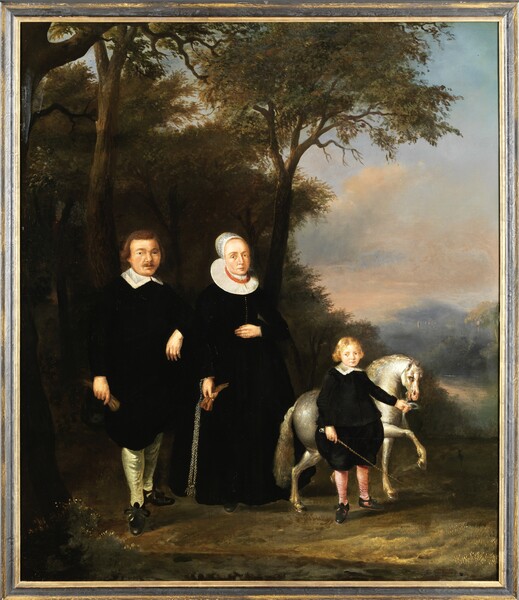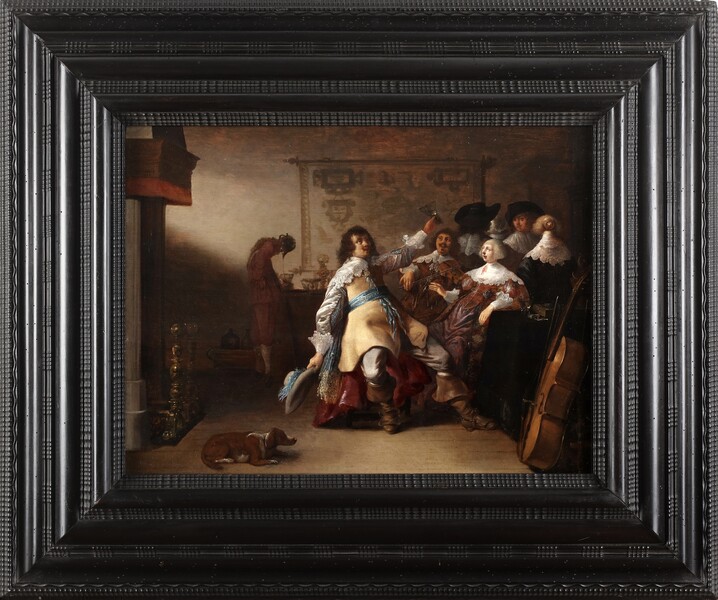
Joseph van Aken
"A lady and her maid buying vegetables, a young thief attempting to steal her watch"
14.000 €
"A lady and her maid buying vegetables, a young thief attempting to steal her watch"
14.000 €
Anonymous 16th century German painter from Nuremberg or Augsburg
"Portrait of a young woman"
2500 €
"Portrait of a young woman"
2500 €
first half 17th century Anonymous French painter
"The crowning of a poet (?)"
5.500 €
"The crowning of a poet (?)"
5.500 €
Leandro Bassano
"Portrait of a lute player"
6.500 €
"Portrait of a lute player"
6.500 €

After Cornelis II Bloemaert
"A poulterer with a chicken"
2.000 €
"A poulterer with a chicken"
2.000 €

Attributed to Herman Doncker
"A family portrait with a small pony"
11.000 €
"A family portrait with a small pony"
11.000 €
Jacob Duck
"Interior scene with two men and a woman"
14.500 €
"Interior scene with two men and a woman"
14.500 €

Attributed to Gottfried I Eichler
"A jester pointing at his marotte"
6.500 €
"A jester pointing at his marotte"
6.500 €
Attributed to Adriaen Hanneman
"Portrait of Lord Francis Villiers"
5.500 €
"Portrait of Lord Francis Villiers"
5.500 €
Attributed to Matthijs Harings
"Portrait of a young man"
2.900 €
"Portrait of a young man"
2.900 €

Wolfgang Heimbach
"Portrait of a cavalier on horseback (Archduke Leopold Wilhelm of Austria?)"
8.500 €
"Portrait of a cavalier on horseback (Archduke Leopold Wilhelm of Austria?)"
8.500 €
Matheus van Helmont
"The wife of an alchemist saddened by his stubborn perseverance"
11.000 €
"The wife of an alchemist saddened by his stubborn perseverance"
11.000 €

Jan Jozef I Horemans
"A cobbler working in front of his home"
3.000 €
"A cobbler working in front of his home"
3.000 €
Jan Jozef II Horemans
"The notary"
7.500 €
"The notary"
7.500 €
Jan Jozef II Horemans
"A visit to the doctor"
7.500 €
"A visit to the doctor"
7.500 €
Attributed to Juriaen Jacobsz.
"Portrait of a lady "
7.500 €
"Portrait of a lady "
7.500 €

Jan Baptist Lambrechts
"A gallant company drinking tea under a palm tree"
6.000 €
"A gallant company drinking tea under a palm tree"
6.000 €
Bartholomeus Molenaer
"A painter at work"
6.100 €
"A painter at work"
6.100 €
Jan Miense Molenaer
"A merry company in a tavern"
8.500 €
"A merry company in a tavern"
8.500 €
Monogrammist IG
"The tobacco seller"
2.500 €
"The tobacco seller"
2.500 €

Constantijn Netscher
"Portrait of Charles du Han de Martigny "
9.000 €
"Portrait of Charles du Han de Martigny "
9.000 €

circa 1630 Northern Caravaggesque painter
"A young man playing the tenor recorder"
33.000 €
"A young man playing the tenor recorder"
33.000 €

Willem van Odekercken
"A servant girl"
9.500 €
"A servant girl"
9.500 €

Jürgen Ovens
"Portrait of a lady with her granddaughter"
10.000 €
"Portrait of a lady with her granddaughter"
10.000 €
Anthonie Palamedesz.
"An elegant company playing music"
12.000 €
"An elegant company playing music"
12.000 €

Anthonie Palamedesz.
"A merry company"
13.000 €
"A merry company"
13.000 €

Attributed to Peeter Snyers
"A young Savoyard and his pet animal"
1.500 €
"A young Savoyard and his pet animal"
1.500 €
Attributed to Hendrick Martensz. Sorgh
"A courting scene"
4.500 €
"A courting scene"
4.500 €

Early 17th century Flemish follower of Lucas van Valckenborch
"The wine press"
3.000 €
"The wine press"
3.000 €

Adriaen Pietersz. van de Venne
"It is all about the profit"
9.500 €
"It is all about the profit"
9.500 €

Circle of Jan Victors
"One of a pair of portraits"
the pair/9.500 €
"One of a pair of portraits"
the pair/9.500 €

Circle of Jan Victors
"One of a pair of portraits"
the pair/9.500 €
"One of a pair of portraits"
the pair/9.500 €
Cornelis Mathijsen van der Weele
"A couple playing the lute"
3.300 €
"A couple playing the lute"
3.300 €
